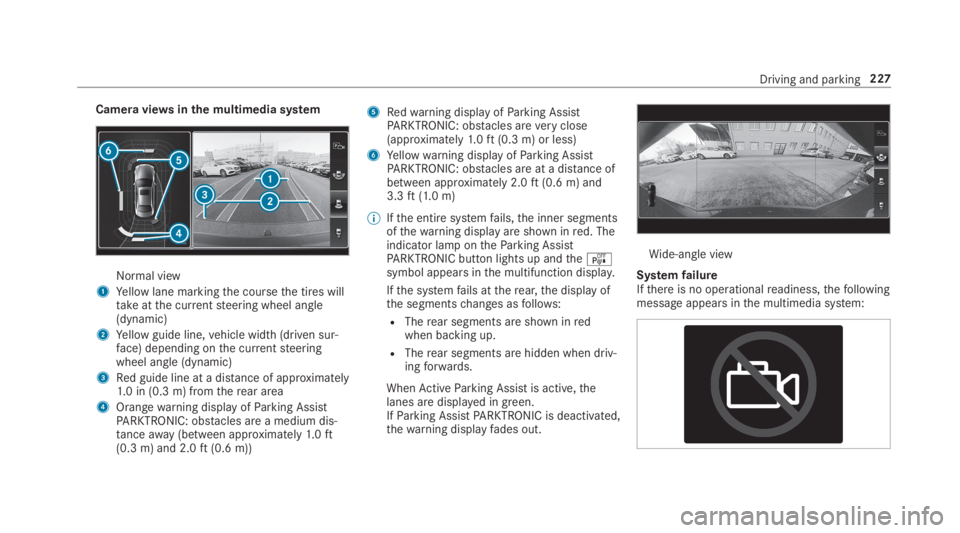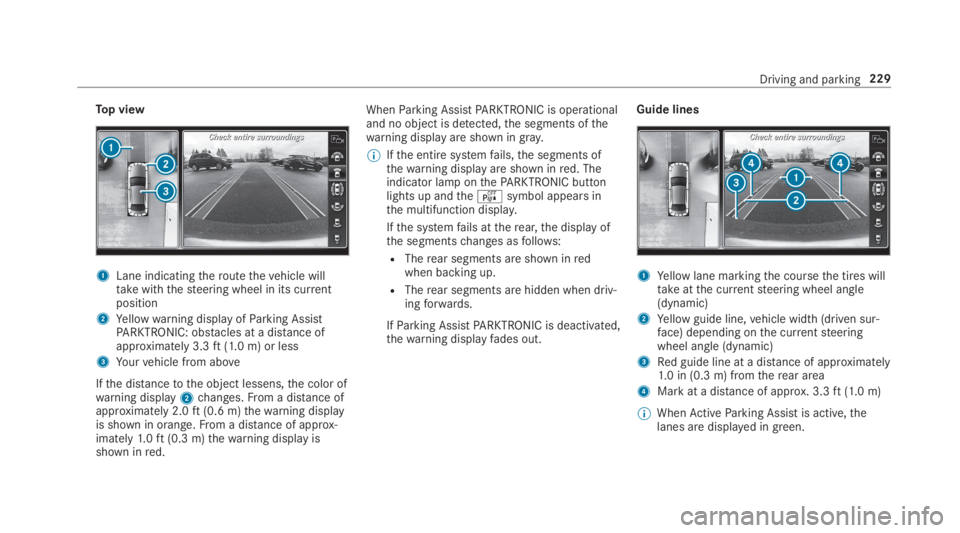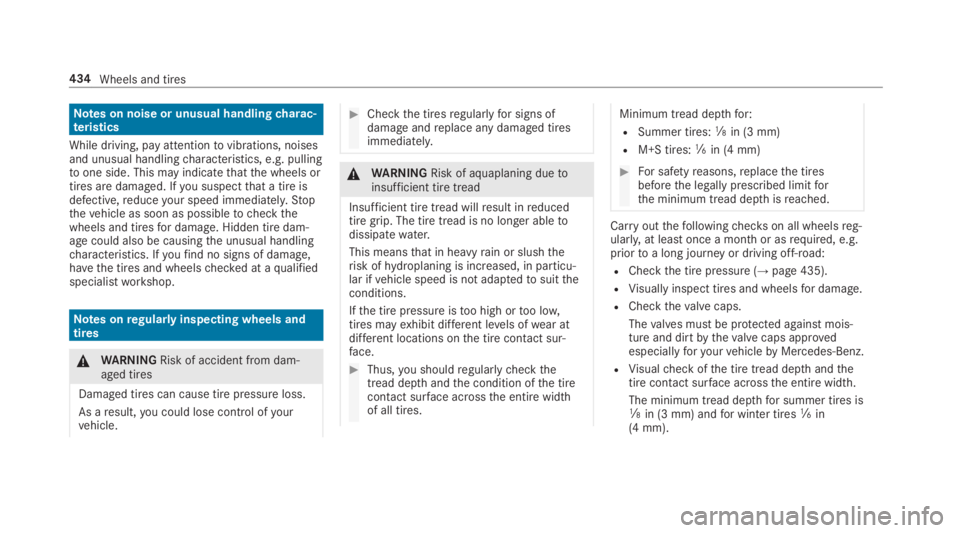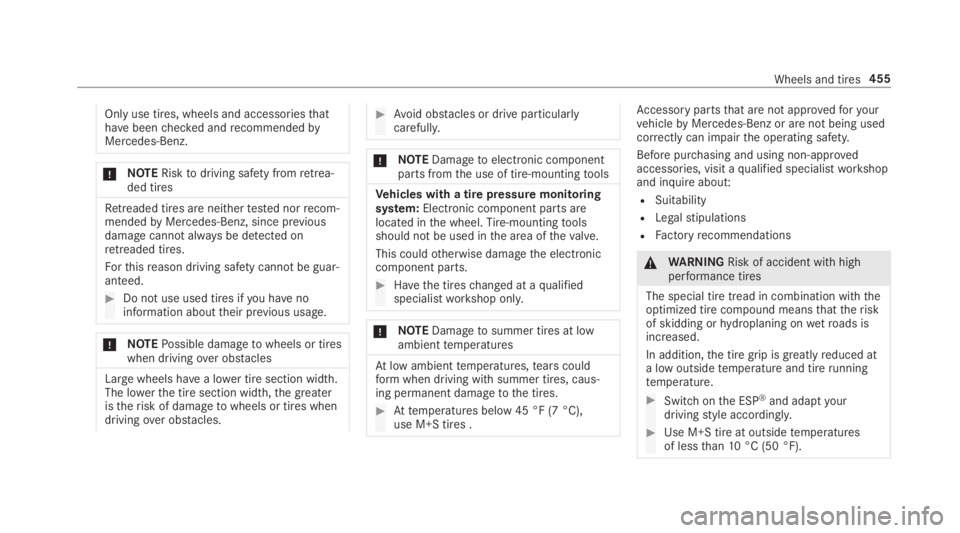2019 MERCEDES-BENZ S CLASS width
[x] Cancel search: widthPage 229 of 578

Camera viewsinthe multimedia system
Normal view
1Yellow lane markingthe coursethe tires willtakeatthe currentsteering wheel angle(dynamic)
2Yellow guide line,vehicle width (driven sur‐face) depending onthe currentsteeringwheel angle (dynamic)
3Red guide line at a distance of approximately1.0 in (0.3 m) fromtherear area
4Orangewarning display ofParking AssistPARKTRONIC: obstacles are a medium dis‐tanceaway(between approximately1.0ft(0.3 m) and 2.0ft(0.6 m))
5Redwarning display ofParking AssistPARKTRONIC: obstacles areveryclose(approximately1.0ft(0.3 m) or less)
6Yellowwarning display ofParking AssistPARKTRONIC: obstacles are at a distance ofbetween approximately 2.0ft(0.6 m) and3.3ft(1.0 m)
%Ifthe entire systemfails,the inner segmentsofthewarning display are shown inred. Theindicator lamp ontheParking AssistPARKTRONIC button lights up andtheésymbol appears inthe multifunction display.
Ifthe systemfails attherear,the display ofthe segmentschanges asfollows:
RTherear segments are shown inredwhen backing up.
RTherear segments are hidden when driv‐ingforwards.
WhenActiveParking Assist is active,thelanes are displayed in green.IfParking AssistPARKTRONIC is deactivated,thewarning displayfades out.
Wide-angle view
SystemfailureIfthere is no operationalreadiness,thefollowingmessage appears inthe multimedia system:
Driving and parking227
Page 231 of 578

Top view
1Lane indicatingtheroutethevehicle willtakewiththesteering wheel in its currentposition
2Yellowwarning display ofParking AssistPARKTRONIC: obstacles at a distance ofapproximately 3.3ft(1.0 m) or less
3Yourvehicle from above
Ifthe distancetothe object lessens,the color ofwarning display2changes.From a distance ofapproximately 2.0ft(0.6 m)thewarning displayis shown in orange.From a distance of approx‐imately1.0ft(0.3 m)thewarning display isshown inred.
WhenParking AssistPARKTRONIC is operationaland no object is detected,the segments ofthewarning display are shown ingray.
%Ifthe entire systemfails,the segments ofthewarning display are shown inred. Theindicator lamp onthePARKTRONIC buttonlights up andtheésymbol appears inthe multifunction display.
Ifthe systemfails attherear,the display ofthe segmentschanges asfollows:
RTherear segments are shown inredwhen backing up.
RTherear segments are hidden when driv‐ingforwards.
IfParking AssistPARKTRONIC is deactivated,thewarning displayfades out.
Guide lines
1Yellow lane markingthe coursethe tires willtakeatthe currentsteering wheel angle(dynamic)
2Yellow guide line,vehicle width (driven sur‐face) depending onthe currentsteeringwheel angle (dynamic)
3Red guide line at a distance of approximately1.0 in (0.3 m) fromtherear area
4Mark at a distance of approx. 3.3ft(1.0 m)
%WhenActiveParking Assist is active,thelanes are displayed in green.
Driving and parking229
Page 405 of 578

#Removecap1bythetab, place onthe edgeofthefiller opening and engage in place.
#Addwasherfluid.
Keepingthe air-water duct free
#Keepthe area betweenthe hood andthewindshield free of deposits, e.g. ice, snowand leaves.
Cleaning and care
Notes onwashingthevehicle in a carwash
&WARNINGRisk of accident duetoreduced braking effect afterwashingthevehicle
The braking effect isreduced afterwashingthevehicle.
#Afterthevehicle has beenwashed,brake carefully while paying attentiontothe traffic conditions untilthe brakingeffect has been fullyrestored.
*NOTEDamageduetounsuitable carwash
#Before driving into a carwash makesurethatthe carwash is suitableforthevehicle dimensions.
#Ensurethere is sufficient ground clear‐ance betweenthe underbody andtheguiderails ofthe carwash.
#Ensurethatthe clearance width ofthecarwash, in particularthe width oftheguiderails, is sufficient.
Toavoid damageto yourvehicle when using acarwash, ensurethefollowing beforehand:
RActive Distance AssistDISTRONIC andtheHOLD function are deactivated.
Rthe 360° Camera ortherear view camera isswitched off.
Rthe side windowsand sliding sunroof arecompletelyclosed.
Rthe blowerfortheventilation/heating isswitched off.
Rthe windshield wiper switch is in position�Z.
Rin carwashes with a conveyor system: neu‐tral�\\is engaged.
Rthe SmartKeyis at a distance of at least10ft(3 m)awayfromthevehicle,otherwisethetrunk lid could open unintentionally.
Maintenance and care403
Page 436 of 578

Notes on noise or unusual handlingcharac‐teristics
While driving, pay attentiontovibrations, noisesand unusual handlingcharacteristics, e.g. pullingtoone side. This may indicatethatthe wheels ortires are damaged. Ifyou suspectthat a tire isdefective,reduceyour speed immediately.Stopthevehicle as soon as possibletocheckthewheels and tiresfor damage. Hidden tire dam‐age could also be causingthe unusual handlingcharacteristics. Ifyoufind no signs of damage,havethe tires and wheelschecked at aqualifiedspecialistworkshop.
Notes onregularlyinspecting wheels andtires
&WARNINGRisk of accident from dam‐aged tires
Damaged tires can cause tire pressure loss.
As aresult,you could lose control ofyourvehicle.
#Checkthe tiresregularlyfor signs ofdamageandreplace any damaged tiresimmediately.
&WARNINGRisk of aquaplaning duetoinsufficient tire tread
Insufficient tire tread willresult inreducedtire grip. The tire tread is no longer abletodissipatewater.
This meansthat in heavyrain or slushtherisk ofhydroplaning is increased, in particu‐lar ifvehicle speed is not adaptedtosuittheconditions.
Ifthe tire pressure istoo high ortoo low,tires mayexhibit different levels ofwear atdifferent locations onthe tire contact sur‐face.
#Thus,you shouldregularlycheckthetread depth andthe condition ofthe tirecontact surface acrossthe entire widthof all tires.
Minimum tread depthfor:
RSummer tires:�
Page 451 of 578

Neverexceed maximum tire pressure1speci‐fiedforthe tire.
Information on tirecharacteristics
%The data shown inthe image isexampledata.
This information describesthe type of tire cordandthe number of layersin sidewall1andunder tire tread2.
Tiresize designation, load-bearing capacity,speedrating and load index
&WARNINGRisk of injurythroughexceed‐ingthe specified tire loadrating orthepermissible speedrating
Exceedingthe specified tire loadrating orthe permissible speedrating may leadtotiredamageandtothe tires bursting.
#Therefore, only use tire types and sizesapprovedforyourvehicle model.
#Observethe tire loadrating and speedratingrequiredforyourvehicle.
1Preceding letter
2Nominal tire width in millimeters
3Aspectratio in %
4Tirecode
5Rim diameter
6Load-bearing index
7Speedrating
8Load index
%The data shown inthe image isexampledata.
Information aboutreading tire data can beobtained from anyqualified specialistworkshop.
Wheels and tires449
Page 452 of 578

Preceding letter11:RWithout: passengervehicle tires accordingtoEuropean manufacturingstandards.
R"P": passengervehicle tires accordingtoUSmanufacturingstandards.
R"LT": light truck tires accordingtoUS manu‐facturingstandards.
R"T": compact emergency sparewheels withhigh tire pressurethat are only designedfortemporary use in an emergency.
Aspectratio33:Ratio between tire height and tire width in per‐cent (tireheight dividedbytire width).
Tire code44(tiretype):R"R"radial tire
R"D": bias ply tire
R"B": bias belted tires
R"ZR":radial tire with a maximum speed above149mph (240 km/h) (optional)
Rim diameter55:The diameter ofthe bead seat (notthe diameteroftherimflange). Therim diameter is specifiedin inches (in).
Load-bearing index66:Numerical codethat specifiesthe maximumload-bearing capacity of a tire (e.g. "91" corre‐spondsto1356 lbs (615kg)).
The load-bearing capacity ofthe tire must be atleast halfthe permissible axle load ofyourvehi‐cle. Do notoverloadthe tiresbyexceedingthespecified load limit.
See also:
RMaximum permissible load ontheTireandLoading Information placard (→page442)
RMaximum tire load (→page448)
RLoad index
Speedrating77:Specifiesthe approved maximum speed ofthetire.
%An electronic speed limiter preventsyourvehicle fromexceeding a speed of130mph(210km/h).
Makesurethatyour tires havetherequiredspeedrating.You can obtain information ontherequired speedrating from an authorizedMercedes-Benz Center.
Summer tires
IndexSpeedrating
Qupto100mph (160 km/h)
Rupto106mph (170 km/h)
Supto112mph (180 km/h)
Tupto118mph (190 km/h)
Hupto130mph (210km/h)
Vupto149mph (240 km/h)
Wupto168mph (270 km/h)
Yupto186mph (300 km/h)
450Wheels and tires
Page 455 of 578

these are installed onthevehicle, but does notinclude passengers or luggage.
Maximum tire load:the maximum tire load isthe maximum permissibleweight in kilograms orlbsfor whicha tire is approved.
Maximum permissible tire pressure:maxi‐mum permissible tire pressurefor one tire.
Maximum load on one tire:maximum load onone tire. This is calculatedbydividingthe maxi‐mum axle load of one axlebytwo.
PSI (pounds per square inch):standard unit ofmeasurementfor tire pressure.
Aspectratio:ratio between tire height and tirewidth in percent.
Tirepressure:pressure insidethe tire applyingan outwardforcetoeverysquare inch ofthe tire.The tire pressure is specified in pounds persquare inch (psi), in kilopascals (kPa) or in bar.The tire pressure should only be corrected whenthe tires are cold.
Cold tire pressure:the tires are cold whenthevehicle has been parkedfor at least3 hours
without direct sunlight onthe tires orthevehiclehas been drivenfor lessthan 1 mile (1.6 km).
Tirecontact surface:the part ofthe tirethatcomes into contact with theroad.
Tirebead:the purpose ofthe tire bead istoensurethatthe tire sits securely onthe wheelrim. There are several wire cores inthe tire beadtopreventthe tire fromchanging length onthewheelrim.
Sidewall:the part ofthe tire betweenthe treadandthe tire bead.
Weight of optional equipment:the combinedweight ofthe optional equipmentweighing morethanthereplacedstandard parts and morethan5 lbs (2.3kg).This optional equipment, such ashigh-performance brakes, level control system, aroof luggagerackor high-performance batteries,is not included inthe curbweight andtheweightofthe accessories.
TIN (Tire IdentificationNumber):a uniqueidentification number which can be usedby atire manufacturertoidentify tires,forexample,in a productrecall, andthus identifythe pur‐chasers. The TIN is made up ofthe manufactur‐
er's identity code, tire size, tire type code andthe manufacturing date.
Load-bearing index:the load-bearing index is acodethat containsthe maximum load-bearingcapacity of a tire.
Traction:traction isthe gripresulting from fric‐tion betweenthe tires andtheroad surface.
Wear indicator:narrowbars (treadwear bars)that are distributedoverthe tire contact surface.Ifthe tire tread is level withthe bars,thewearlimit of 1/16in (1.6 mm) has beenreached.
Distribution ofvehicle occupants:distributionofvehicle occupantsover designated seat posi‐tions in avehicle.
Maximum permissible payloadweight:nomi‐nal load and luggage load plus150 lb (68kg)multipliedbythe number of seats inthevehicle.
Wheels and tires453
Page 457 of 578

Only use tires, wheels and accessoriesthathavebeenchecked andrecommendedbyMercedes-Benz.
*NOTERisktodriving safety fromretrea‐ded tires
Retreaded tires are neithertested norrecom‐mendedbyMercedes-Benz, since previousdamage cannot always be detected onretreaded tires.
Forthisreason driving safety cannot be guar‐anteed.
#Do not use used tires ifyou havenoinformation abouttheir previous usage.
*NOTEPossible damagetowheels or tireswhen drivingover obstacles
Large wheels havea lower tire section width.The lowerthe tire section width,the greateristherisk of damagetowheels or tires whendrivingover obstacles.
#Avoid obstacles or drive particularlycarefully.
*NOTEDamagetoelectronic componentparts fromthe use of tire-mountingtools
Vehicles with a tire pressure monitoringsystem:Electronic component parts arelocated inthe wheel.Tire-mountingtoolsshould not be used inthe area ofthevalve.
This couldotherwise damagethe electroniccomponent parts.
#Havethe tireschanged at aqualifiedspecialistworkshop only.
*NOTEDamagetosummer tires at lowambienttemperatures
Atlow ambienttemperatures,tears couldformwhen driving with summer tires, caus‐ing permanent damagetothe tires.
#Attemperatures below 45 °F (7 °C),use M+S tires .
Accessory partsthat are not approvedforyourvehiclebyMercedes-Benz or are not being usedcorrectly can impairthe operating safety.
Before purchasing and using non-approvedaccessories, visit aqualified specialistworkshopand inquire about:
RSuitability
RLegalstipulations
RFactoryrecommendations
&WARNINGRisk of accident withhighperformance tires
The special tire tread in combination withtheoptimized tire compound meansthattheriskof skidding orhydroplaning onwetroads isincreased.
In addition,the tire grip is greatlyreduced ata low outsidetemperature and tirerunningtemperature.
#Switch onthe ESP®and adaptyourdrivingstyle accordingly.
#Use M+S tire at outsidetemperaturesof lessthan10°C (50 °F).
Wheels and tires455